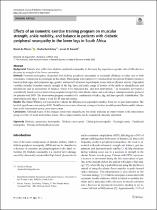| dc.contributor.author | du Plessis, Ronél | |
| dc.contributor.author | Dembskey, Nadia | |
| dc.contributor.author | Bassett, Susan H | |
| dc.date.accessioned | 2022-08-11T07:48:51Z | |
| dc.date.available | 2022-08-11T07:48:51Z | |
| dc.date.issued | 2022 | |
| dc.identifier.citation | du Plessis R, Dembskey N, Bassett SH. Effects of an isometric exercise training program on muscular strength, ankle mobility, and balance in patients with diabetic peripheral neuropathy in the lower legs in South Africa. Int J Diabetes Dev Ctries. 2022 Apr 5:1-6. doi: 10.1007/s13410-022-01068-1. Epub ahead of print. PMID: 35400974; PMCID: PMC8980507. | en_US |
| dc.identifier.uri | 10.1007/s13410-022-01068-1 | |
| dc.identifier.uri | http://hdl.handle.net/10566/7721 | |
| dc.description.abstract | Background: Patients who suffer from diabetic peripheral neuropathy in the lower leg experience a greater risk of falls due to a decrease in strength of the lower extremities.
Methods: Fourteen participants, diagnosed with diabetic peripheral neuropathy or nocturnal allodynia in either one or both extremities, volunteered to participate in this study. Participants were purposively selected from two private Podiatry practices based on their signs and symptoms, age, gender, and doctor's clearance to participate in any form of physical activity. Dependent variables included isometric muscle strength of the hip, knee and ankle, range of motion of the ankle in plantarflexion and dorsiflexion and an assessment of balance, which were measured pre- and post-intervention. The researcher developed a scientifically based exercise intervention program to target the entire kinetic chain, and to develop a standard isometric protocol for patients with DPN. The intervention program consisted of a combination of ankle, hip, and knee specific rehabilitation. The intervention took place 3 times a week for 45 min per session.
Results: The Mann-Whitney test was used to evaluate the differences in dependent variables from pre- to post-intervention. The level of significance was set at p<0.05. Notable increases were observed in range of motion in ankle plantarflexion and in balance time in the intervention group, post-intervention.
Conclusions: Although many of the changes noted were insignificant, the trends indicated an improvement in the intervention group over the 10-week intervention period. These improvements can be considered clinically important. | en_US |
| dc.language.iso | en | en_US |
| dc.publisher | Springer | en_US |
| dc.subject | Diabetic autonomic neuropathy | en_US |
| dc.subject | Diabetic nerve pain | en_US |
| dc.subject | Distal polyneuropathy | en_US |
| dc.subject | Hyperglycemia | en_US |
| dc.subject | Peripheral neuropathy | en_US |
| dc.subject | Pressure air biofeedback system | en_US |
| dc.title | Effects of an isometric exercise training program on muscular strength, ankle mobility, and balance in patients with diabetic peripheral neuropathy in the lower legs in South Africa | en_US |
| dc.type | Article | en_US |

